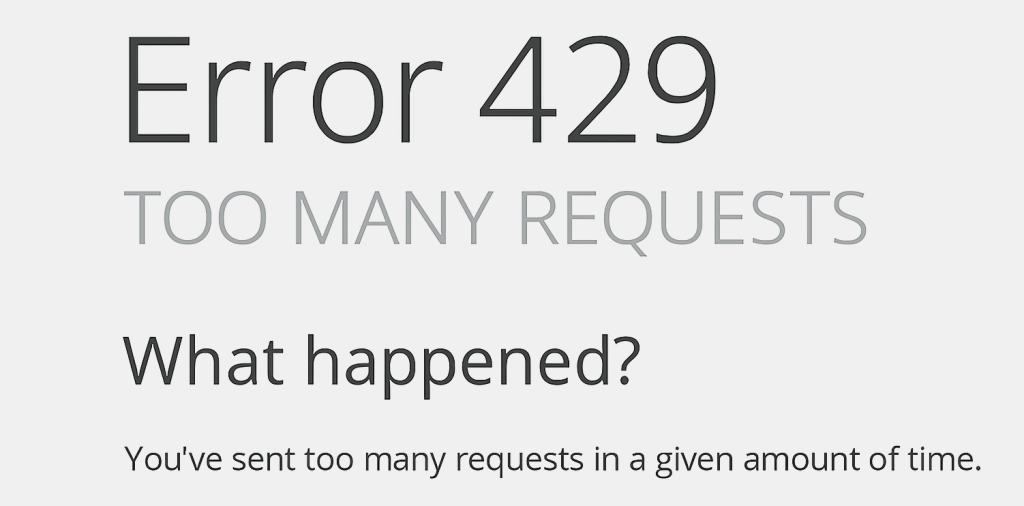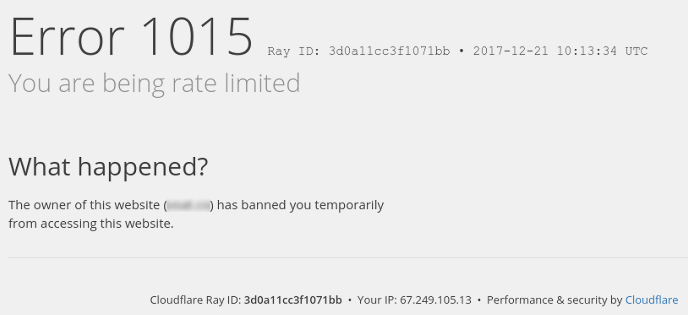
 en
en  Español
Español  中國人
中國人  Tiếng Việt
Tiếng Việt  Deutsch
Deutsch  Українська
Українська  Português
Português  Français
Français  भारतीय
भारतीय  Türkçe
Türkçe  한국인
한국인  Italiano
Italiano  Gaeilge
Gaeilge  اردو
اردو  Indonesia
Indonesia  Polski
Polski Error Code 1015 appears when Cloudflare restricts access to a website due to suspiciously high activity. Cloudflare is a global content delivery network (CDN) and web security platform that filters traffic, caches pages, manages DNS, and protects sites from DDoS attacks. If too many requests come from a single IP address, the protection system is triggered and temporarily blocks access. This disrupts normal browsing, script execution, scraping, and similar activities.
What is error 1015 meaning and how to fix the issue depending on its cause – read below.

This problem is not related to internal failures of the web resource and does not depend on the user’s browser. In the context of Cloudflare, Error 1015 means an HTTP response generated by the platform when a set query limit is exceeded from a single IP address, session, or device.
With error 1015 rate limited it is defined by the site’s policies – for example, 10 calls within 5 seconds from one IP. At the same time, not only the number of attempts is recorded. Additional parameters come into play: query path, HTTP method (GET, POST, etc.), cookies, headers, and behavioral patterns. This makes it possible to distinguish between, for example, mass scraping and legitimate user actions. The blocking code is returned only in cases of suspicious activity.

Both issues arise from identical causes but differ in how they are handled:


If Cloudflare is not used, error will not appear — instead, code 429 or another internal blocking mechanism will take effect.
The platform blocks access if a user’s or program’s actions match patterns of automated behavior. Below are the main reasons for triggering protection and how this manifests in real-world scenarios.
| Trigger | Cloudflare Reaction | Consequences |
|---|---|---|
| High frequency of calls to an internet resource | Detects excessive activity with short intervals | The site does not load: the page freezes or a problem message appears |
| Repeated requests without actions on the page | Recognizes patterned requests typical of automation | Script or parser stops working, Error 1015 appears, or the page remains blank |
| Suspicious or shared IP | Blocks traffic from IPs with low reputation or overloaded concurrent activity | The error occurs on the first visit to the website, the platform blocks access |
| No interaction with the site | Detects absence of mouse movements, clicks, or viewport changes | Page loading stops and/or the message “You are being rate limited” appears |
| Cookie or token conflicts | Detects duplicate or outdated authentication parameters | Failure occurs when logging into an account or placing an order, the page does not load |
Below are typical scenarios in which protection is triggered and specific methods for resolving the issue in each case.
Automated queries without signs of real user interaction (mouse movements, scrolling, clicks) are classified as suspicious. Sessions with high-frequency repeated calls are blocked by the system.
How to fix it:
These measures help avoid triggering protective filters, working within their conditions when handling large volumes of requests to a resource.
Error code 1015 can occur not only due to frequent requests but also from unstable internet connections. Slow Wi-Fi, connection drops, high ping, packet loss, DNS issues, or temporary ISP outages can cause page loading to pause and resume. For traffic filtering systems, this looks like suspicious activity, which may trigger blocking.
How to fix it:
Timely resolution of network issues reduces the risk of false positives from security filters and ensures stable operation even on resources with strict request rate limits.
If an IP address has a low reputation (e.g., previously used for spam or automation) or is actively used by other users, Cloudflare may immediately block access — even before the page loads or authorization occurs.
How to fix it:
If necessary, contact the site administrator with a description of the situation and a request for unblocking.
Cloudflare may detect a conflict with authorization data (cookies, tokens) when attempting to access secure sections of a site. Repeated or outdated parameters can trigger an access error.
How to fix it:
If the problem persists, contact the site’s support team to resolve the authorization issue.
When running automated scenarios (parsers, macros, auto-clickers), the system analyzes user behavior when loading the page. If there are no actions such as cursor movement, scrolling, or clicks, the session may be classified as automated and restricted.
How to fix it:
By simulating real user behavior, the risk of blocking is reduced, ensuring stable access to the website’s functionality.
To minimize the risk of encountering such an issue, it is important to understand the reasons behind it and apply the right technical solutions.
| Tool | Purpose | When to Use |
|---|---|---|
| Rotating proxies (mobile, residential) | Changing the IP address for each request or at set intervals | Parsing, auto-clickers, mass actions, multi-accounting |
| Antidetect browsers (Dolphin, GoLogin) | Managing profiles, sessions, and browser fingerprints | Simultaneous work with multiple accounts, user behavior emulation |
| Frameworks with UI emulation support (Puppeteer, Selenium) | Simulating user activity: mouse movements, scrolling, delays | Automation while maintaining “human-like” behavior |
| Traffic analysis tools (DevTools, Fiddler) | Monitoring HTTP headers, cookies, server responses | Diagnosing restriction triggers, debugging script behavior |
| API request management services (Apify, Scrapy SPM) | Controlling request frequency and distributing load by sessions | Large-scale data collection, working with public APIs |
Read our previously prepared material on what rotating proxies are to better understand their role in solving error 1015.
Error Code 1015 is not a technical malfunction but a signal of suspicious activity. It occurs when request frequency limits are exceeded, behavioral patterns are absent, or the IP address is of low quality. This issue often arises during parsing, multi-accounting, and automation. To bypass it, it is crucial to understand the causes of restrictions and rely only on proven solutions: rotating proxies, antidetect browsers, UI emulators, etc.
For stable access even to highly protected resources using Cloudflare, it is recommended to use our residential or mobile private proxies with a high trust factor.
Yes. Browser extensions, auto-refreshing pages, or background tabs can create excessive activity and trigger a block.
Usually, from a few minutes to an hour, but the exact duration depends on the system settings of the specific site. Repeated requests to the resource without behavioral changes (e.g., scripts) may extend the block.
This is usually related to the network’s IP address. If the IP has a poor reputation, was previously blacklisted, or is simultaneously used by multiple devices, the system may restrict access. Connecting via another network or mobile internet changes the IP, preventing the block.
Comments: 0